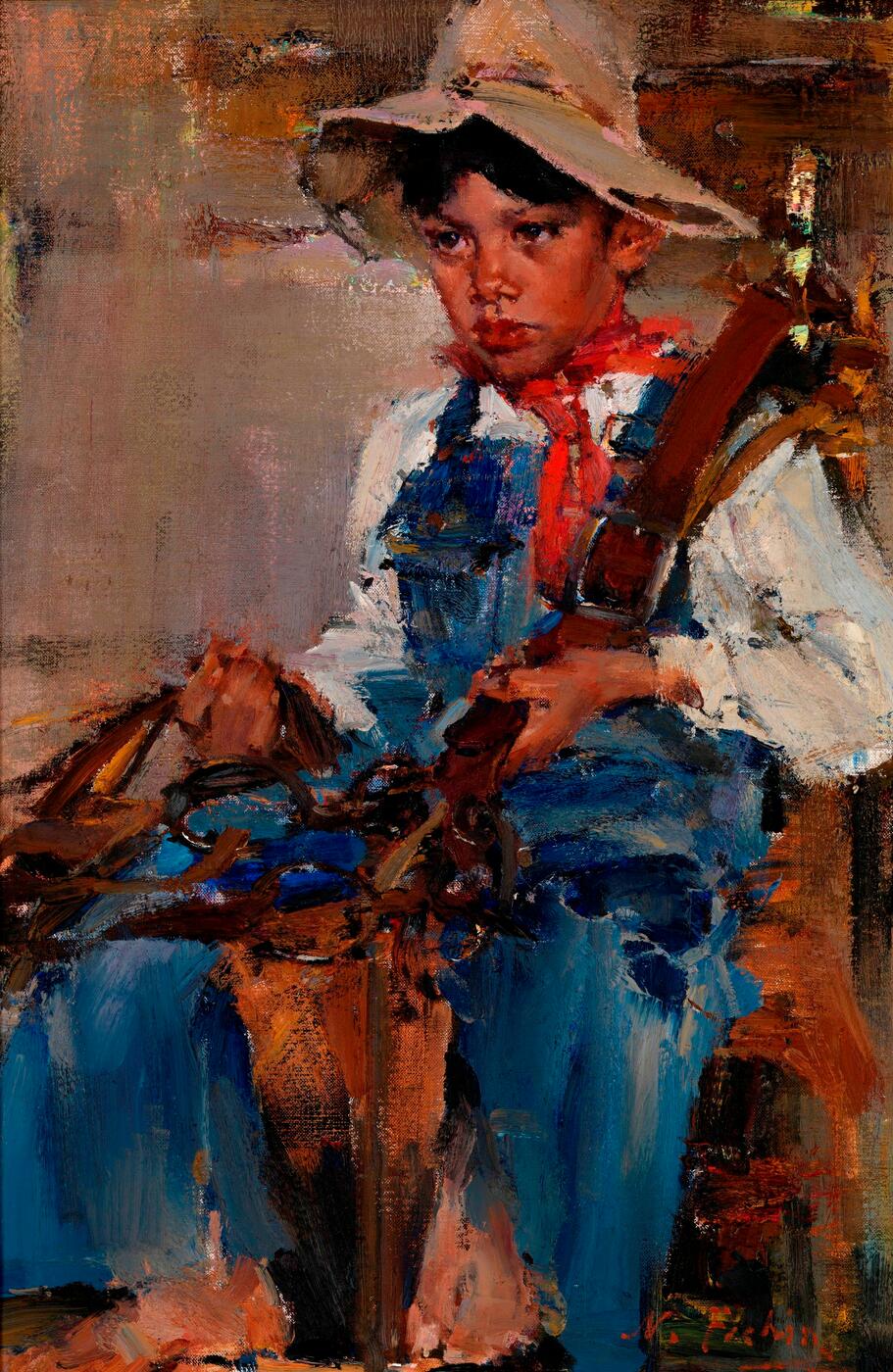MacDougall's Russian Art Auctions 1-2 Dec 2010
1 December 2010

* 313. FECHIN, NIKOLAI 1881-1955
The Little Cowboy signed
Oil on canvas, 76 by 51 cm.
500,000-700,000 GBP
Provenance: Stendahl Galleries, Los Angeles, label on the reverse.
Property from the Estates of Walter and Sonja Caron Stein.
Private collection, Europe.
Authenticity has been confirmed by the expert V. Petrov.
Related Literature: For similar works, see G. Tuluzakova, Feshin, Zolotoy Vek, St Petersburg, 2007, pp. 134 and
The Little Cowboy is one of Nikolai Fechin’s most brilliant portraits of childhood dating from his time in the USA. Painted in 1940 it is — like Fechin’s early masterpiece, the portrait of Varya Adoratskaya (1914) — not only an expression of the credo of this artist, arguably the best painter of children of the 20th century, but also in its way an act of escapism, a conscious retreat from the harsh reality of two world wars, day-to-day hardships and various social cataclysms.
Fechin was especially fond of children’s portraits. Even with all the problems of working with child models, quickly tiring and constantly fidgeting, the artist was able to assemble a whole gallery of childhood images, executed with an unequalled lightness of touch and effortlessly communicating the essence of his models and, at the same time, notable for the depths revealed in the subject portrayed. Even the commissioned, formal portraits which were the artist’s bread and butter in America are without any trace of mawkishness or sentimentality and distinguished by the highest draughtsmanship and technical virtuosity.
It is worth noting that the image of the little cowboy is not just a tribute to the local colour of Fechin’s American environment. He had lived for several years in the little township of Taos, in upstate New Mexico, at the foot of the Sangre de Cristo Mountains, and knew at first hand the life of the farmers and cowboys who inhabited this picturesque mountain terrain and would from time to time sit for the artist. Even later on, after he had moved in 1934 to a permanent home in Los Angeles, he often took the journey — beneficial for his tuberculosis-damaged lungs — south-westwards, to where the rancheros of Arizona and New Mexico as well as the local Indians would continue to model for him.
The artist was especially happy to paint such portraits en plein air, under the hot sun, often placing his model against the light, filling the expanse of the canvas with a golden heat haze, and almost always preserving the "study-like" nature of his sweeping, virtuoso painting style. However, this image of the little cowboy is characteristic not only of this free technique: it also offers a striking contrast, with a clear distinction between the painting method adopted for the face, with light, almost invisible brushstrokes, and the impasto rendering of clothes and background.
Despite the preparatory sketch-lines in the boy’s face being delicately worked to convey the young equestrian’s composure and concentration, it seems likely that Fechin painted the portrait in a single sitting, given the integrity and the immediacy with which he captures the pose and the child’s passion for horse-riding, and the vivacity and temperament of the painting technique. The spontaneous artistic freedom of the image structure and the precisely conveyed and idiosyncratic riding position of the wiry figure of the child give the portrait an inner dynamism. Yet we do not see the horse itself, nor a wagon — for despite all the child’s preoccupation and the tightly clenched reins the lad, seated by the artist on the corner of a chair or a chest, is only, it seems, playing at horse-riding. But the authenticity of the "cowboying" is of no concern to Fechin, for it merely provides the composition of the portrait and the fundamental reason for that childish seriousness, the boy’s concentration on some distant point. The artist is utterly and completely focused on the image of the boy. He delights in the gentle face, chubby lips, brown eyes and the flush of those apple cheeks. The precise balance between the areas of colour, with the boy’s denim dungarees and red cowboy scarf providing vivid flashes against a subdued grey background, tells us a lot about Fechin, a refined and sophisticated colourist, who can derive from three basic colours a wealth of shades vibrating with light.
The Little Cowboy is not only an outstanding example of Fechin’s masterly painting skill but also an expressive image of childhood, the seriousness and gentleness of which embody the authentic lyricism inherent in the very best of this artist’s childhood portraits.
Notes on symbols:
* Indicates 5% Import Duty Charge applies.
Ω Indicates 20% Import Duty Charge applies.
§ Indicates Artist's Resale Right applies.
† Indicates Standard VAT scheme applies, and the rate of 20% VAT will be charged on both hammer price and premium.